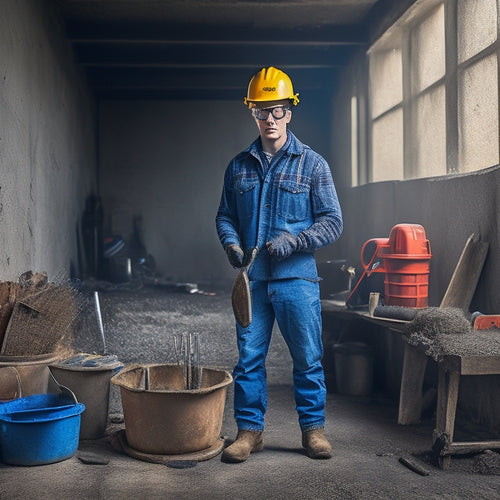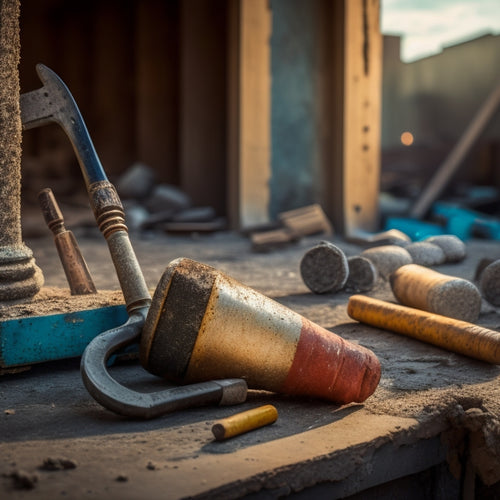
7 Must-Have Tools for Vertical Concrete Repair
Share
You'll need the right tools to tackle vertical concrete repair projects that require precision and control for durable and long-lasting results. Start with a vertical crack injection gun for delivering epoxy or polyurethane resin into cracks, and pair it with flexible injection packings that allow for easy flow and material delivery. High-pressure pumps and hoses are essential for efficient material injection, while epoxy resin mixing machines guarantee accurate proportioning and thorough blending. Don't forget concrete surface preparation tools, crack cleaning and prep brushes, and measuring and mixing accessories to complete your toolkit. Now, you're ready to plunge into the specifics of each tool to secure a successful repair.
Key Takeaways
• Injection equipment, including vertical crack injection guns and flexible injection packings, is essential for delivering epoxy or polyurethane resin into cracks.
• High-pressure pumps and hoses, along with pump selection criteria and pressure control systems, ensure efficient material delivery for larger repairs.
• Surface preparation tools, such as wire brushes, scarifiers, grinders, and vacuum cleaners, ensure a strong bond between old concrete and new materials.
• Mixing and measuring equipment, including epoxy resin mixing machines and measuring accessories, guarantee accurate proportioning and thorough blending of repair compounds.
• Bond strength considerations, including material compatibility and environmental factors, are crucial for ensuring a strong and durable bond between the repair material and surrounding concrete.
Vertical Crack Injection Guns
When repairing vertical concrete cracks, you'll need a reliable vertical crack injection gun to effectively deliver epoxy or polyurethane resin into the crack, ensuring a strong and durable bond. This tool is essential for successful crack sealing, allowing you to inject the resin at the correct pressure and flow rate. A high-quality injection gun will provide you with the necessary control and precision to achieve ideal results.
To master injection techniques, it's vital to understand the importance of gun selection. Look for a gun with adjustable flow control, allowing you to tailor the injection rate to the specific crack size and resin type.
Additionally, consider a gun with a built-in pressure gauge, enabling you to monitor and maintain the ideal pressure during the injection process. By choosing the right vertical crack injection gun, you'll be able to execute precise and effective crack sealing, ensuring a long-lasting repair that withstands environmental stresses.
High-Pressure Pumps and Hoses
As you prepare for vertical concrete repair, you'll need to select the right high-pressure pump and hose system for the job.
You'll want to take into account key factors such as pump flow rate, pressure output, and motor type to guarantee you're getting the right tool for your specific application.
Next, you'll need to choose the appropriate hose material and think about implementing a pressure control system to optimize performance and safety.
Pump Selection Criteria
You need to contemplate several key factors when selecting a high-pressure pump and hose system for vertical concrete repair, including the pump's flow rate, pressure rating, and material compatibility.
The flow rate, typically measured in gallons per minute (GPM), determines how quickly you can inject repair materials into the concrete. For larger repairs, you'll need a pump with a higher flow rate to guarantee efficient material delivery.
When it comes to pump types, you'll encounter diaphragm, piston, and plunger pumps. Diaphragm pumps are ideal for lower-pressure applications, while piston and plunger pumps can handle higher pressures.
Consider the pressure rating required for your specific repair job and choose a pump that can meet those demands. Additionally, verify the pump is compatible with the repair materials you'll be using, as some pumps may not be suitable for certain materials.
Hose Material Options
Selecting the right hose material for your high-pressure pump is essential, as it directly impacts the overall performance, durability, and safety of your vertical concrete repair operation.
You'll want to evaluate hose compatibility considerations, verifying the material is compatible with the pump's fluid type and operating pressure. For instance, thermoplastic hoses are ideal for high-pressure applications, while rubber hoses are better suited for lower-pressure uses.
When assessing hose durability factors, you'll want to take into account factors like abrasion resistance, flexibility, and kink resistance. A hose that's prone to kinking or abrasion can lead to reduced performance, increased downtime, and even safety hazards. Look for hoses with reinforced layers, such as braided or spiral-wound constructions, which provide added strength and durability.
You'll also want to examine the hose's working temperature range, as well as its resistance to chemicals and UV degradation. By selecting a hose that meets your specific application requirements, you can guarantee a reliable, efficient, and safe vertical concrete repair operation.
Pressure Control Systems
Effective pressure control systems, comprising high-pressure pumps and hoses, are essential to maintaining a consistent and controlled flow of repair material in vertical concrete repair applications. You need to make certain that your system can deliver the required pressure and flow rate to successfully inject repair materials into the concrete.
When selecting a high-pressure pump, consider the maximum pressure rating, flow rate, and power source. You'll also want to choose hoses that can withstand the high pressures and are resistant to abrasion, corrosion, and damage from the repair materials. Pressure calibration is vital to guarantee accurate control over the injection process.
Injection safety is a top priority, so make sure your system includes features such as pressure relief valves, burst disks, and safety gauges. These components will help prevent over-pressurization and protect you and your team from injury.
Epoxy Resin Mixing Machines
Precision mixing is critical when working with epoxy resin, and a reliable epoxy resin mixing machine guarantees consistent batch-to-batch results. You can't afford to compromise on the quality of your epoxy mixture, as it directly impacts the success of your vertical concrete repair project.
A high-quality mixing machine guarantees that the epoxy resin is accurately proportioned, thoroughly blended, and free of air bubbles. This, in turn, affects the epoxy's curing time, strength, and overall performance.
When selecting an epoxy resin mixing machine, consider the type of epoxy you're working with, the quantity you need to mix, and the desired consistency. Look for machines with adjustable speed and timer controls, as well as those that can handle high-viscosity epoxies.
A good mixing machine will also allow you to master various epoxy application techniques, such as injection, pouring, or brushing. By using a reliable mixing machine, you'll be able to achieve consistent, high-quality results and optimize your epoxy curing methods.
Don't take chances with your epoxy mixture – invest in a superior mixing machine to guarantee the success of your vertical concrete repair project.
Concrete Surface Preparation Tools
You'll need to equip yourself with the right concrete surface preparation tools to guarantee a strong bond between the old concrete and the new repair material. Preparing the surface is essential to make sure the new material adheres properly and lasts for a long time.
To achieve the desired concrete surface textures, you'll require the following tools:
-
Wire brushes to remove loose debris and create a rough surface for better bonding
-
Scarifiers to remove old coatings, mastics, or deteriorated concrete
-
Grinders to smooth out the surface and create a uniform texture
- Vacuum cleaners to remove dust and debris from the prepared surface, guaranteeing a clean surface for the application of surface bonding agents
Flexible Injection Packings
When it comes to flexible injection packings, you'll need to evaluate the type of injection material that's best suited for your vertical concrete repair job.
You'll also want to think about the design options for your packing, as this will impact the effectiveness of the repair.
Injection Material Selection
Selecting the right flexible injection packing for your vertical concrete repair project is crucial, as it directly impacts the effectiveness and longevity of the repair. You need to take into account the type of injection material that suits your project's specific requirements. There are various injection material types, each with its own strengths and weaknesses.
When selecting an injection material, think about the following key factors:
-
Material viscosity: Confirm the material flows easily through the packing and into the crack or void.
-
Curing time considerations: Choose a material with a curing time that aligns with your project's timeline and environmental conditions.
-
Chemical resistance: Select a material that can withstand exposure to chemicals or water, if necessary.
- Bond strength: Opt for a material that forms a strong bond with the surrounding concrete.
Packing Design Options
Flexible injection packings come in various designs, each tailored to optimize the flow of injection material and guarantee a successful vertical concrete repair.
As you choose the right packing design for your project, you'll need to take into account factors such as design aesthetics, which can impact the overall appearance of the repaired area. You'll also want to prioritize packaging durability to make sure the packing can withstand the injection pressure and material flow.
One popular design option is the spiral-cut packing, which allows for a consistent flow of material while minimizing pressure buildup.
Another option is the fluted packing, which features a unique shape that promotes efficient material distribution and reduces the risk of clogging.
You may also take into account packings with specialized features, such as anti-bleed valves or built-in pressure gauges, to further optimize the injection process.
Crack Cleaning and Prep Brushes
You'll need a sturdy crack cleaning and prep brush to thoroughly remove dirt, debris, and old filler material from the crack before applying a vertical concrete repair compound. This vital step guarantees a strong bond between the concrete and the repair material.
When it comes to cleaning techniques, using the right brush type can make all the difference. Here are some essential brushes to have in your toolkit:
-
Stiff-bristled brushes: Ideal for removing thick dirt and debris from wide cracks.
-
Soft-bristled brushes: Suitable for cleaning small cracks and crevices without damaging the surrounding concrete.
-
Wire brushes: Effective for scrubbing away stubborn dirt and old filler material.
- Nylon brushes: Gentle on the concrete surface and perfect for dusting away fine particles.
Measuring and Mixing Accessories
Accurate measurements are crucial when mixing vertical concrete repair compounds, and having the right measuring and mixing accessories guarantees a consistent blend that meets the manufacturer's specifications. You'll need measuring tools like digital scales, measuring cups, and mixing buckets to guarantee precise proportions. Digital scales, in particular, are essential for measuring small quantities of additives or accelerators.
When it comes to mixing techniques, you'll want to invest in a high-torque drill and a mixing paddle or jiffy mixer. These tools will help you achieve a uniform consistency and prevent lumps from forming. A mixing paddle with a rubber edge is also useful for scraping the sides and bottom of the mixing bucket.
Additionally, consider investing in a mixing stick or spatula for smaller batches or for mixing materials in tight spaces. By having the right measuring and mixing accessories, you'll be able to achieve a consistent, high-quality repair that meets the manufacturer's specifications and lasts for years to come.
With these tools, you'll be well-equipped to tackle even the most complex vertical concrete repair projects.
Frequently Asked Questions
What Safety Precautions Should I Take When Working With Epoxy Resin?
When working with epoxy resin, you must prioritize epoxy safety.
Always handle the resin in a well-ventilated area, away from heat sources and open flames.
Wear protective gear, including gloves, safety glasses, and a mask to prevent skin contact and inhalation of fumes.
Guarantee you're working on a level, stable surface to prevent spills and accidents.
Proper resin handling is key, so follow the manufacturer's instructions and take your time to avoid mistakes.
Can I Use a Regular Drill for Mixing Epoxy Resin and Hardener?
When it comes to mixing epoxy resin and hardener, you'll want to be strategic about your tools.
While you might think a regular drill will do the trick, it's not the best choice. The high drill speed can introduce air into the mixture, causing bubbles and weakening the bond.
Instead, opt for a low-speed drill or a dedicated mixing paddle to guarantee thorough, air-free mixing.
This attention to epoxy mixing techniques will pay off in the long run, so don't skimp on the details.
How Do I Prevent Air Bubbles From Forming in the Epoxy Mixture?
Did you know that 80% of epoxy mixing errors occur due to air bubble formation? To prevent this, you'll need to master epoxy mixing techniques.
When combining resin and hardener, make certain to mix slowly and deliberately, scraping the sides and bottom of the container to eliminate air pockets.
Additionally, use a mixing stick with a flat, wide head to minimize bubble formation.
What Is the Ideal Temperature for Conducting Vertical Concrete Repairs?
When conducting vertical concrete repairs, you need to guarantee ideal conditions for the epoxy to cure properly.
Temperature plays a vital role, as it directly affects the curing process. You'll want to aim for a temperature range of 60°F to 80°F (15°C to 27°C), as this allows for a slow and controlled cure.
Temperature effects can be significant, so avoid extreme temperatures, which can lead to uneven curing, brittleness, or even delamination.
Can I Reuse Flexible Injection Packings After a Single Use?
When it comes to flexible injection packings, you're probably wondering if you can reuse them after a single use.
The answer lies in their longevity. While it's tempting to reuse them to cut costs, it's generally not recommended.
The packing's flexibility and seal integrity degrade with each use, compromising the repair's quality.
Instead, opt for cost-effective solutions that prioritize durability and performance, ensuring your vertical concrete repairs stand the test of time.
Conclusion
You've got the right tools for the job, and now it's time to tackle that vertical concrete repair like a surgeon with a scalpel.
With these 7 must-haves in your arsenal, you'll be able to precision-craft a solution that's as solid as the concrete itself.
Remember, a successful repair is like building a house of cards - it requires patience, precision, and the right foundation.
Get it right, and you'll be standing tall; get it wrong, and it'll all come crashing down.
Related Posts
-

What Tools Do I Need for Concrete Wall Repair
As you prepare for a concrete wall repair job, you'll need a variety of tools to guarantee a successful outcome. Star...
-

Essential Power Tools for DIY Concrete Sculpting
As you begin DIY concrete sculpting, you'll need a strategic selection of power tools to achieve professional-grade r...
-

5 Tips for Splitting Concrete With Second-Hand Tools
When splitting concrete with second-hand tools, you'll need to be strategic to avoid wasting time, money, and putting...


